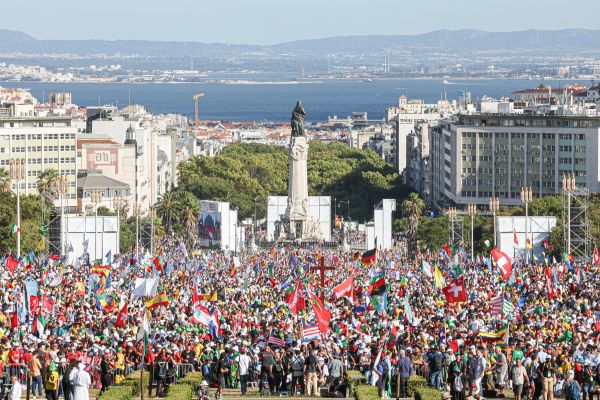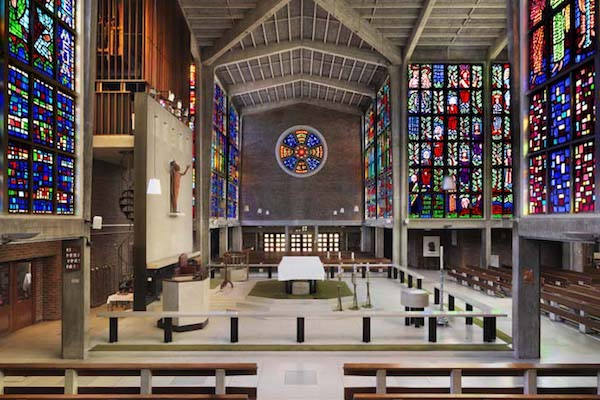One of England’s most influential modernist churches, Our Lady of Fátima, Harlow, has had its listing upgraded to Grade II*.
The decision will help safeguard the future of the church which needs urgent repairs to the roof and its landmark needle spire.
Our Lady of Fátima, opened in 1960, was the first ecclesiastical commission undertaken by Gerard Goalen (1918-1999), an important British architect of the Catholic Modernist Movement.
Goalen’s design was among the first in England to be informed by the Liturgical Movement which sought to engage the congregation in worship. It is said to have influenced the design of Liverpool Metropolitan Cathedral.
The church is famous for the brilliant-coloured glass windows that cover around 60 per cent of the walls. They depict the Joyful Mysteries of the Rosary, the Tree of Jesse, and the apparitions of the Virgin Mary at Fátima.
Dom Charles Norris OSB, of Buckfast Abbey, made the windows using the dalle de verre technique in which slabs of glass are cut, chipped at the edges to make them glitter, then embedded in cement or resin.
Norris went on to undertake some 250 dalle de verre schemes at churches across the UK.
Suzi Pendlebury, director of Thomas Ford and Partners, who acted as inspecting architect for the church, believes that upgrading the listing from Grade II was necessary given the church’s national significance.
She said: “The parish was able to save the dalle de verre windows with the help of Historic England. With growing recognition of Our Lady of Fatima’s national significance, I trust the parish may receive greater financial support to repair the roof and spire so that this church can keep inspiring and serving the community who depend on it.”
Parish priest Fr Boguslaw Kot MS said the parish had raised £200,000 to repair the spire. He is anxious to complete this work and to return the cross at the top.
However, at least another £300,000 is needed for a new roof, a sum beyond the means of a small parish with a second church to care for.
“I am praying the upgrade will help us to get some grants,” he said.
Gerard Goalen was recommended to design the church by Sir Frederick Gibberd (1908-1990), who was master-planner and chief architect of Harlow New Town. Goalen was working with Gibberd at the time, designing factories for the town’s industrial estates.
Goalen worked closely with the new town’s parish priest, Fr Francis Burgess, who in 1953 asked him to design a church capable of holding up to 500 people, with a freestanding altar in the middle of the congregation.
The church was built in a T-shape with a reinforced concrete frame. Gibberd’s last-minute winning entry in the competition to design Liverpool Metropolitan Cathedral is said to have been influenced by his attendance at the Harlow church’s opening Mass.
The listing upgrade by the Department of Culture, Media and Sport was made on the advice of Historic England, whose chief executive Duncan Wilson said: “This stunning church was created as part of the new town of Harlow, offering a brighter and better future in the post-war years, and has been at the heart of the community ever since.”
He continued: “With its modern style, striking spire and glorious glass panels, it has proved an inspiration in contemporary church design and is loved by people who take comfort in its calming, beautiful presence every day.”
The Bishop of Brentwood, Alan Williams, welcomed the listing.
“It is an important church architecturally, not just in the diocese but nationally,” he said. “It was one of the first of its kind and unique for its stained glass.”
Clare Price, head of casework at Twentieth Century Society, said that the church was “a pioneer of a unified scheme of dalle de verre glass and modern design”.
“The effect on walking into the church is uplifting, the feeling of entering a shifting kaleidoscope of colour coupled with the radical new liturgical arrangement of the interior must surely have made many a new town worshipper gasp in astonishment,” she said.
“It has lost nothing of its impact in the intervening years, the interior being of such stunning jewel-like quality that it was chosen as the front cover illustration for our book 100 Churches 100 Years, while the exterior was even featured on the cover of a Chemical Brothers’ album!” (Brothers Gonna Work It Out, 1998)



 Loading ...
Loading ...